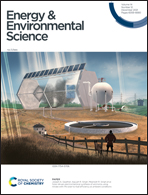A wood-templated unidirectional piezoceramic composite for transmuscular ultrasonic wireless power transfer†
Abstract
Bioelectronic devices implanted within the human body are increasingly used for diagnostic and therapeutic purposes, in which their functions and lifespan could be significantly improved with wireless energy transfer technology. However, limited by electromagnetic radiation, low power output, high stiffness, short transfer distance and tissue attenuation, most wireless energy transfer systems cannot meet the requirements of implantable medical devices (IMDs). Here, inspired by natural wood structures, we present a transmuscular ultrasonic wireless power transfer system based on a flexible wood-templated piezoelectric ultrasonic energy harvester (W-PUEH) in a unidirectional 3D interconnected ceramic–polymer topology. The developed flexible W-PUEH device demonstrates an output voltage of 21 V, an output current of 2 mA, and an average output power density of 304 μW cm−2, one order of magnitude higher than the state of the art. Further ex vivo and in vivo experiments demonstrate the sufficient power supply capacity of W-PUEH and its potential applications in implantable devices for the improvement of life quality and well-being of the recipients.



 Please wait while we load your content...
Please wait while we load your content...